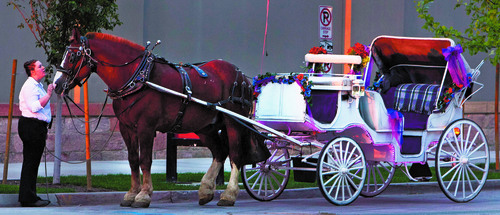This is an archived article that was published on sltrib.com in 2014, and information in the article may be outdated. It is provided only for personal research purposes and may not be reprinted.
A proposal that would give the Salt Lake City Council more direct oversight of the horse-drawn carriage business in the capital city appears to be a good solution for both horses and people.
Although most people would rather see horses grazing in green pastures with comfy barns nearby than pulling fancy carriages on city streets, there is a place for such conveyances in cities like Salt Lake City. But the businesses that operate them must be much more closely supervised, with tighter rules to make sure the horses are well-treated and work only when the weather is mild.
After Jerry, a carriage horse owned by Carriage for Hire and employed to pull a carriage on downtown city streets, collapsed and later died under rather clandestine circumstances last summer, the city took a look at the situation but punted the issue to the 2014 council, which has three rookie members.
That newly constituted council is considering allowing the horse-drawn carriages to continue operating, but only under contract with the city. That would move oversight from the business licensing department to the City Council.
After Jerry's demise, the council found a rather confusing system of regulation had allowed Carriage for Hire to be out of compliance with regulations. Although the city issued the company a business license under city ordinances, Salt Lake County Animal Services contracts with Salt Lake City on animal-related issues and was supposed to enforce regulations. The county reported that the company violated the city's ordinance on several occasions, including recently, when the carriage company was operating during the afternoon and evening rush hour and was warned.
The council is still discussing what rules to include in a contract. Among the better ideas: Carriage horses should be at least 3 years old, should work no more than eight hours a day with a 10-minute break each hour, and should not work more than five days a week.
There is disagreement on several other important issues, including the weather conditions when horses should not be allowed to work and whether carriages should stay off certain busy streets. While horses have long worked in urban settings, it's not appealing to see them plodding along Salt Lake streets in severely hot or cold weather, obviously in distress. And it's certainly not good for the animals.
Allowing carriage businesses to operate under tighter regulations and better oversight is worth a try, but keeping them operating if that doesn't work isn't worth putting horses or people at risk.



